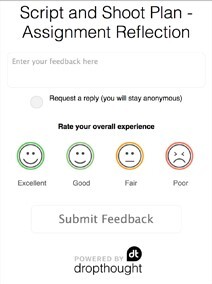DROPTHOUGHT: FEEDBACK ON COLLEGE COURSES RIGHT HERE, RIGHT NOW

Ever been told by a professor in a class to “hold that thought”? Well, Michael Atkisson, a graduate student in Instructional Psychology and Technology at BYU, would say to drop it.
DropThought is a two-way instant feedback system that allows students to give instructors anonymous, real-time feedback on their learning. With the DropThought mobile app or LMS widget, students leave feedback spontaneously or as prompted by their instructors in a simple three-step process: select an assignment, enter a comment and a sentiment that represents their overall experience, and click “Submit Feedback.”

Instructors can see and respond to anonymous comments, sort comments by topic, and track trends by viewing sentiments over time, among other features.

Michael Atkisson didn’t set out with the intent to work on this revolutionary new system; rather, his road to DropThought was more indirect. Atkisson was working for Stanford’s graduate school of business as an instructional designer creating MOOCs—Massive Open Online Courses, a learning format where tens of thousands of students take a single course at the same time, often from a well-known instructor—when the DropThought team reached out to him because they needed someone with expertise in learning and training for a large project with Starbucks. At the time, DropThought was providing instant customer feedback to business owners and managers in hospitality and dining. Atkisson, who had been looking for an opportunity in product development, took the project, but also saw the potential for DropThought to be utilized in higher education. Soon after the beginning of the project, he left Stanford to build a new business line for the early stage startup. DropThought was going to college.
DropThought equips online instructors with a system that allows students to give honest, real-time feedback on specific areas of their learning, which, according to Atkisson, provides great benefit to both student and instructor. “Professors get questions that students are normally too timid to ask. I see it as a real potential safety net for those who are new to what school is and haven’t figured out what it means to be a student yet. On the other side of things, what the instructor gets is a new playing field of data that is very different from anything that is out there today,” he observed.
Much course feedback today comes from students either through self-identified means (emails, face to face, etc.), which restricts candidness, or through surveys, which happen after the course is completed and tend to have low student participation. In many cases, little is done with such feedback. Conversely, DropThought lets students reflect on their learning or say what they need to throughout the course, leading to higher participation and more ownership of their learning all along the way. Instructors can then respond to that feedback and pinpoint areas for improvement as the course progresses. Atkisson said, “It’s one thing to receive a comment here and there about unclear instructions in an assignment, but it’s another when you have feedback from all your students on the assignment and 70% thought the instructions were unclear.” In addition, the institutions that subscribe to DropThought can get a better analysis of what students struggle with and what they respond well to. “I really see this as a watershed tool,” says Atkisson. “We can make use of this information in the right way by the right people.”
As DropThought grows in higher ed, the big idea is to use the large-scale, anonymous, real-time student feedback it collects for administrators to shape cross-institutional benchmarks and for instructors to more effectively tailor their syllabus to student need and interest. Since the launch of its higher education campaign several weeks ago, DropThought has had professors from more than 20 universities, including schools like Stanford, Harvard, Old Dominion University, USC, and a variety of community colleges, take advantage of the free signup for educators to use the platform. Atkisson and the rest of the DropThought team hopes to see hundreds and even tens of thousands of professors utilize the platform to enhance the student learning experience. And the vision doesn’t stop there; efforts are in progress to expand the scope of DropThought into the healthcare industry, facilitating more effective communication between healthcare professionals and their patients.
When asked what advice he would give to anyone who wanted to do something innovative, Atkisson responded, “In any capacity you have as a student or professional or parent or member of the church, there are always ways to do things better. Sometimes you don’t have a lot of room to innovate, but you can take to those areas with a lot of pride. To be anxiously engaged with your cause is to be fresh and innovative in the things you want to accomplish. Innovation is not an event; it’s an approach to life.”

Michael Atkisson is a doctoral student in the instructional psychology and technology department at BYU, but currently lives in California with his lovely wife and three wonderful children. He is the senior director in product and business development for DropThought and wrote his dissertation on semantic analysis of real-time student feedback.